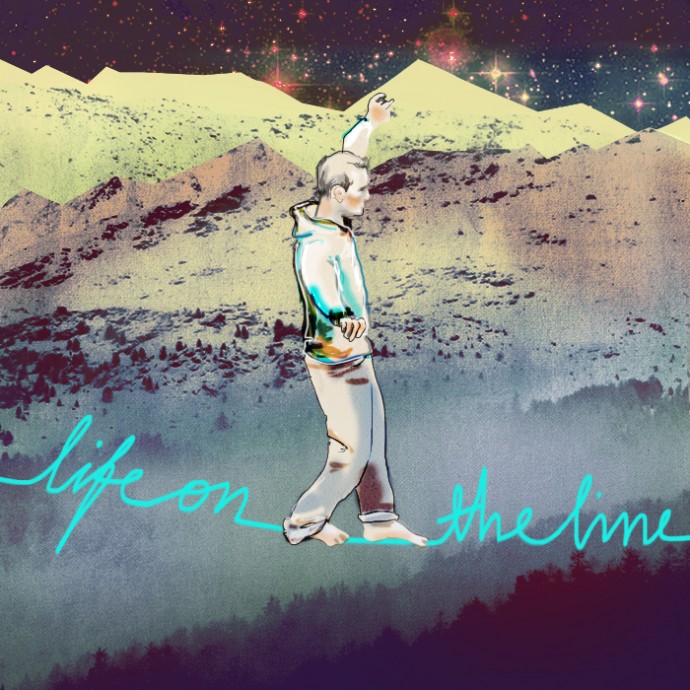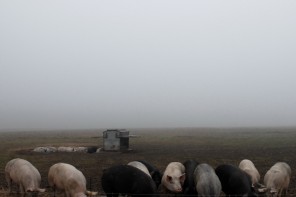Jordan Tybon is a passionate highliner and a co-founder of Somewhereelseland, a project that seeks to inspire people to do the impossible. He talks with Sensa Nostra about what motivates him to walk a slackline several hundreds of meters above the ground free-solo, and what pushes him to never quit trying.
I first came across slacklining several years ago, when my friends set up a rope at my local gym. It looked interesting, and I gave it a try. More precisely, I gave it a lot of tries, before I finally crossed the two and a half centimeters wide slackline successfully. It was just so hard—it was like learning how to walk again. For me, it was fascinating how much energy you had to put into it just to cross that little slackline. It was a challenge, and that’s what attracted me the most. People need challenges in their lives.
They need something to push them forward, to make them get off the couch, stop watching television re-runs and just do something. Do anything! It doesn’t even matter what it is, as long as they find something they’re passionate about and start doing that. A lot of people have fallen into these static routines—and this is a really easy thing to do, since routines always give us a feeling of safety and security—but we need to realize that there can be much more to life than this comfortable stagnation. People shouldn’t fear trying new things and stepping beyond this fence that they have put up for themselves.
Fear has always had a bad connotation, but it is not necessarily a bad thing. You can use fear to your advantage. You have an option to turn your fear, the thing you’re being enslaved to, into your slave. It’s only the first step—making a decision to face it and then actually doing that—that is hard. And it definitely is hard, there’s no denying it. So hard, in fact, that some people never go beyond that point. Keep on fearing, that’s what some do. They fear the fear, they run away from the fear. But what would be more beneficial for them to do, is face it.
All you have to do is recognize that there’s a possibility for you to conquer your fear. Just realizing that has proven to be extremely valuable for me. Because once you know that, you can motivate yourself to do everything necessary to conquer it. When you do that, you’re freed from it, and probably from any other fear that might come your way, too. Because now you know that this fear is not something that will stop you, it’s just a challenge you have to overcome. And if you decide you want to, and you keep working for it, you will prevail over your fears. It’s really simple. That’s how you move on. That’s how you give your life meaning and how you start living a life that is progressing. Don’t satisfy yourself with a stagnant routine, when you have the possibility to do so much more with your life!
I’m not saying there’s a lot of meaningfulness in my life. But I did find something that intrigues me and something that pushes me to move forward. I found it in highlining, which is probably one of the most meaningless activities in existence. Highlining is a made-up problem. There’s nothing inherently valuable about it, there’s no reason to do it. It is utterly senseless. You are aware of that, but still, you spend hours planning the trip, climbing the mountain, setting up the equipment. Before the slackline is set and you’re ready to cross it, you are already so exhausted you feel like there is no way you can do it.
Walking the slackline is actually a really small part of it, it’s just the icing on a cake, like 10% of the whole experience. You put all this energy and emotion into it, and why?
Highlining is a mental play. In its essence, highlining doesn’t differ that much from the now so hip and popular slacklining: you walk the same webbing, using the same technique, doing the same moves as with slacklining. What changes is the height. Even if you walked that line a thousand times before when it was set up a meter of the ground, and you know that there is no way in hell you’d fall off of it, somehow, the height changes everything.
I don’t know if many people would be willing to admit that, but there is this constant doubt in yourself, in your ability, when you are walking a highline. Can I do it? Do I even dare to try it? Can I go up there and put myself into that exposure and make it? And it doesn’t get easier, either, at least I’ve never gotten used to it: that feeling of doubt and of fear is present each time you take that first step on the line. You cannot walk a few centimeters-wide webbing 900 meters above the ground and not think about what might happen if you make a single wrong move.
It’s all about the mental aspect of the whole experience. The ideal mental state when you’re on the line, and what you are always trying to reach, is a state of complete non-existence, of nirvana; not thinking, completely blocking the mind, and completely shutting your consciousness. Don’t think and just do. Just take a step. But even if you’re seeking this non-existence, you are very much present, you’re very much there and very much aware of your body. In that time, your body and your mind are truly one entity. They always are, but in that time, when there is only you and the line and the mountains and absolutely nothing else, you truly become aware of every muscle in your body and you synchronize it completely with your mind.
I have fallen in love with highlining because it gave me the feeling of absolute presence and at the same time, the feeling of complete non-existence. It makes me feel alive, it makes me push myself forward and overcome my fears and doubts—it makes me overcome myself. And that’s the idea: to find something you love and just go for it. Just do it. If necessary, make yourself do it, and start living your life. Preferably someplace other than your living room.







